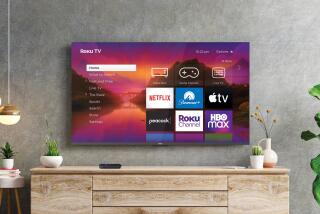After initial flop, Google will try again to launch Android TV
- Share via
Google Inc. still imagines a world in which people talk to their TV, commanding it to switch from ESPN to YouTube, start playing “Orange Is the New Black” on Netflix or answer “What’s the weather like tomorrow?”
But nearly four years after struggling to achieve its vision and watching it flop, Google this week declared that it will try again. At the Google I/O conference for application developers, the company demonstrated a system that purports to tie various devices together to deliver quick access to movies, television shows, video games and Web videos on smartphones, tablets and TVs.
Google’s new run at television validates the importance of owning a piece of the living room, said Colin Dixon of the tech consulting firm nScreenMedia.
The Android operating system simplified work for mobile device manufacturers and now powers about 70% of smartphones worldwide, according to IHS. Forecast by MarketsandMarkets to be worth $265 billion by 2016, the smart-TV market could be far more lucrative for Google.
Engagement, and thus the value of ads, goes up when someone’s watching on a television compared to other screens, Dixon said.
“Google has such a large footprint across smartphones, tablets and other devices that they could create an experience so slick that it’s difficult to match,” he said. “Over time, it is potentially very disruptive.”
Still, the new approach is less bold than the previous attempt. When television sets and media consoles powered by the new Google software arrive as early as this fall, some analysts said, very little could separate Google from long-standing competitors.
In 2010, Sony Corp. and Logitech started selling smart TVs that ran Google software. Through voice commands, physical keyboards or remote controls, users could search the Web, hunt for online video and music streams, or check social media accounts through apps.
But Hollywood feared Google’s encroachment into the living room and limited the content made available to the Web-search-and-ads company. The keyboards and remotes proved clunky.
Now the reincarnation of the failed Google TV platform, known as Android TV, enters a world in which streaming apps from Netflix, Hulu and the content owners themselves have widened the availability of shows and movies online. Smartphones and tablets have introduced more than 1 billion people to the Google-backed Android system, and many of those users have become casual gamers.
So in Android TV, it’s game controllers and not keyboards that will help link users to their television sets and media consoles.
Chris McKillop, engineering manager for Android TV, told software programmers this week that Google would require them to make apps that can be controlled by a simple five-button directional pad rather than a full keyboard and a smattering of buttons. Voice commands, of course, also work. The apps must use simple grid layouts that Google’s dubbed the “Leanback” scheme.
Google will improve the interface too. On the home screen, the most-used apps would be on the left to limit unnecessary scrolling, while specific content recommendations would go up top based on previous viewing, gaming or listening.
McKillop, paraphrasing Android’s design director, told the roomful of developers, “When your butt hits the sofa, you lose 20 IQ points. You don’t want to think. You don’t want to use a computer. You don’t want your TV to be a computer. You want it to entertain you.”
Barbara Kraus, market research director at Parks Associates, said about a third of U.S. households with broadband Internet have smart TVs, a percentage expected to double by 2018.
But the top three smart-TV makers — Samsung Corp., Vizio Inc. and LG Electronics Inc. — all have their own operating systems, and analysts doubted that the companies would use Android TV.
Instead, Google said that it’s Sony, Sharp Corp. and an overseas brand of Philips that plan to release displays that have Android TV and the slate of apps, such as Netflix, TuneIn and Showtime. According to Sony, using Android TV would let it focus on hardware development.
Asus Inc. and Carlsbad, Calif.-based gaming hardware maker Razer are making Android TV consoles that will compete with devices including Roku, Apple TV and Amazon Fire TV. Such devices sit in a fifth of U.S. households with broadband Internet, Kraus said.
Android TV boxes also will have to live alongside Google Chromecast, a stick plugged into HDMI ports that display some apps from Android and iOS on a television. Kraus said 6% of U.S. households with broadband own Chromecast. All told, almost two-thirds of U.S. households with broadband have at least one TV-related device hooked up to the Internet.
Razer said its box would rival others because of a focus on gaming. Game apps draw some of the highest revenues among mobile apps, but analysts said it’s to be seen whether people want to play those games on a big screen. Kraus’ firm said about 11% of Roku users play “Angry Birds,” but wider data weren’t available.
How much content is available through Android TV apps could ultimately determine its fate, analysts said.
“I can get the new ‘Lego’ movie 10 other ways,” said Frost & Sullivan principal analyst Dan Rayburn. “If the content’s not there, consumers won’t get it.”
Twitter: @peard33
More to Read
Inside the business of entertainment
The Wide Shot brings you news, analysis and insights on everything from streaming wars to production — and what it all means for the future.
You may occasionally receive promotional content from the Los Angeles Times.










